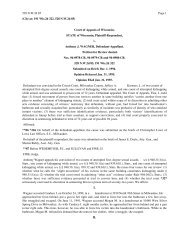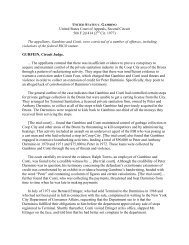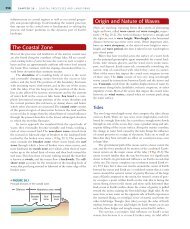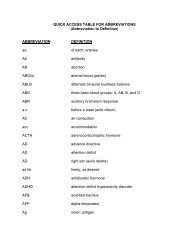Simulink Tutorial on Digital Modulation Methods - Cengage Learning
Simulink Tutorial on Digital Modulation Methods - Cengage Learning
Simulink Tutorial on Digital Modulation Methods - Cengage Learning
You also want an ePaper? Increase the reach of your titles
YUMPU automatically turns print PDFs into web optimized ePapers that Google loves.
13.9. 16-ARY QUADRATURE AMPLITUDE-SHIFT KEYING (16-QAM) 625<br />
2. The trajectory is sampled at rate 1/T. From Figures 13.105 and 13.106 it can<br />
be seen that s_c(2kT ) =±1 and s_s(2kT ) = 0, whereas s_c((2k + 1)T ) = 0<br />
and s_s((2k + 1)T ) =±1. Therefore, sampling the trajectory at 2kT yields<br />
an in-phase point in the scatter plot, whereas sampling at (2k + 1)T yields a<br />
quadrature point.<br />
MSK can be coherently demodulated in the same way as Offset-QPSK followed by<br />
a differential decoder. Therefore, we do not have to deal with demodulati<strong>on</strong> explicitly<br />
here.<br />
13.9 16-ary Quadrature Amplitude-Shift Keying<br />
(16-QAM)<br />
13.9.1 16-QAM with Square-Root Raised-Cosine Pulses<br />
Examine 16-QAM with square-root raised-cosine pulses:<br />
16-QAM > Root-RC<br />
The <str<strong>on</strong>g>Simulink</str<strong>on</strong>g> model and the transmitter model are depicted in Figures 13.113 and<br />
13.114. In 16-QAM, b = 4 bits are mapped <strong>on</strong> a signal-space c<strong>on</strong>stellati<strong>on</strong> point.<br />
Figure 13.113: <str<strong>on</strong>g>Simulink</str<strong>on</strong>g> model for 16-QAM with square-root RC pulses<br />
You can view the signal-space c<strong>on</strong>stellati<strong>on</strong> in Figure 13.115 by double-clicking <strong>on</strong> the<br />
blue box signal-space C<strong>on</strong>stellati<strong>on</strong>.<br />
TUTORIAL PROBLEM<br />
Problem 13.22 [Gray Mapping] Check if the labeling is d<strong>on</strong>e according to a Gray<br />
mapping, i.e., c<strong>on</strong>stellati<strong>on</strong> points with minimum Euclidean distance differ in <strong>on</strong>ly <strong>on</strong>e<br />
bit. What is the purpose of using Gray mapping instead of an arbitrary mapping of bits<br />
to c<strong>on</strong>stellati<strong>on</strong> points? Is Gray mapping possible for higher-order QAM modulati<strong>on</strong>?<br />
© 2013 <strong>Cengage</strong> <strong>Learning</strong>. All Rights Reserved. May not be scanned, copied or duplicated, or posted to a publicly accessible website, in whole or in part.

















